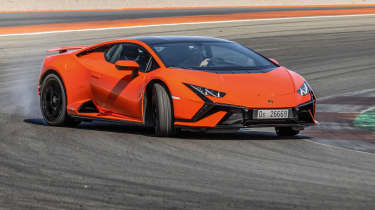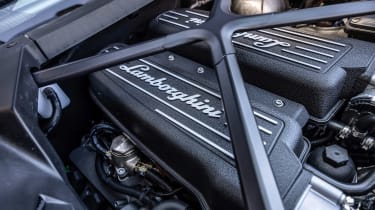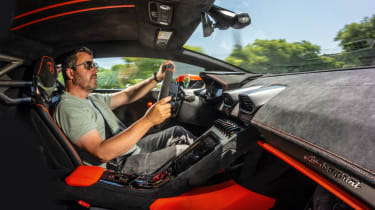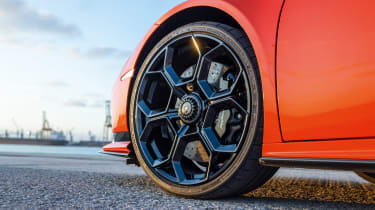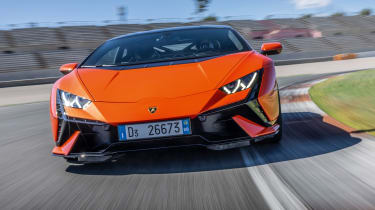Lamborghini Huracán Tecnica 2024 review – a supercar of the old-school
The Huracán will soon be replaced by a V8-engined hybrid, but it’s going out as one of the truly great modern supercars
Auto industry convention dictates ageing model lines should be replaced as soon as possible for fear of falling behind competitors. However, it would appear nobody told Lamborghini, who are still cheerfully spinning new models from the Huracán nine years after we first saw it, back in the winter of 2013.
For once it would appear being last to replace your supercar is a distinct advantage. Not only is the Huracán the last of its kind – that’s to say still using a naturally aspirated, non-hybrid powertrain – but in squeezing the Huracán until its pips squeak, Lamborghini has released a string of driver’s cars blessed with extraordinary ability and irresistible appeal.
> Ferrari 296 GTB 2024 review – fewer cylinders, greater thrills
The Huracán Tecnica (along with the Safari-style Sterrato) is one of these, a full-blooded send-off before Lamborghini’s best-selling model is replaced by an all-new hybridised supercar.
The omens for the Tecnica are good, it being a mash-up of the sublime Huracán Evo RWD and hardcore STO – cars we have fallen for in a big way over the last few years. It would be oversimplifying it to say the Tecnica is Lamborghini’s GT3 Touring, but the notion of a mildly toned-down STO shorn of its track-warrior bodywork is not so far from the mark.
As ever, the devil is in the details. Yes, it takes its howling 631bhp 5.2-litre V10 from the STO, but the styling, chassis set-up, aerodynamics and specifics of each dynamic mode are unique to the Tecnica.
More reviews
Looks-wise there’s much to take in. The front end has received the most attention, with Y-shaped slots, inspired by those on the Terzo Millennio electric hypercar concept, bursting from each headlight. They help generate drag-reducing ‘air curtains’ along the flanks – a first for the Huracán – while a new front splitter balances the front-end downforce and directs cooling air to the brakes.
The side windows and upper intakes have also been tweaked to resemble those of the Essenza SCV12 track car. A new vertical rear window improves visibility and the new carbonfibre decklid is festooned with gills to allow hot air to escape and give glimpses of the V10 engine beneath. The rear bumper is also new, with cutaways allowing hot, turbulant air to escape. Big-bore exhaust pipes poke from hexagonal surrounds, with the modest fixed spoiler completing a sharp and tidy functional makeover.
Possibly the most impressive thing about the restyle is its efficiency. With 35 per cent more rear downforce, 20 per cent less drag and a better overall aero balance than the Evo RWD, the Tecnica cleaves the air more cleanly yet feels more stable at high speed; considered improvements that are indicative of Lamborghini’s desire for the Huracán to go out on a high.
Chassis-wise the Tecnica occupies the space between the STO and RWD with bespoke recalibrated settings within the LDVI’s (Lamborghini Dinamica Veicolo Integrata) familiar Strada, Sport and Corsa driving modes. These make full use of the Huracán’s adaptive damping (the tune of which is closer to the STO than the RWD), rear-wheel steering, torque vectoring and traction control systems to broaden its dynamic repertoire and bring out different characters.
It sounds contrived, but such is the conviction and enthusiasm with which the engineers describe it, getting to know the multi-faceted Tecnica – on both road and track – is an intriguing prospect.
Naturally, we begin in Strada – the most relaxed dynamic mode which backs the dampers off to their softest. 'Are you sure this is the comfortable setting?' your passenger will ask as you bumble around at low speed, their voice trembling as the Tecnica jostles and thumps along the road surface. Even in Strada, the Huracán feels ultra connected and just a bit impatient without much speed beneath its wheels, and it's hard to resist lighting the fuse and tapping into this sense of focus. Get used to the directness of the ride and the letterbox view out and the Huracán is actually very easy and well mannered to drive, but every mile is dusted with a sense of purpose.
When you reach roads that drape themselves across serious topography the Tecnica comes into its own. In fact, when the opportunity arises, the way you can release its performance is nothing less than sensational. You really shouldn’t be able to so readily exploit a rear-drive, mid-engined supercar with 631bhp, yet the Tecnica is so transparent in its behaviour and so accurate and progressive in its responses that it's genuinely playful.
Sport mode is perfectly suited to mountain switchbacks, allowing enough leeway to let the rear end gently slip and slide under power, but with reassurance that the traction control is always there in the background ready to catch the car. The true genius of the Tecnica, though, is that despite the unadulterated violence of the engine and the immediacy of its responses, its edges are malleable when you take liberties with it. The V10 has tremendous reach combined with instant throttle response, and the fidelity with which you can modulate the throttle is so fine it’s possible to make minute adjustments to get the car balanced just-so. It's intuitive, confidence-inspiring and just plain addictive.
And the soundtrack is really something. Mellow at low revs and modest throttle openings, Strada mode enables progress with little more than a murmur, the V10 only opening up if you really extend it. Sport and Corsa bring more vocal range and volume, from bassy tones at low rpm through a rousing baritone midrange to the full nape-prickling Nessun Dorma when you keep it pinned to the 8500rpm limiter. It really is a noise from the gods.
Don’t for a moment think the Tecnica is all mouth and no trousers. The steering – that most critical point of contact – has terrific clarity with measured yet fast responses. Surface feedback buzzes through the Alcantara rim, and while it can be hard to sense the load building through the front end, what you do feel builds an accurate picture of how much grip you have to work with. You soon settle into the process of threading the Tecnica down the road with supreme precision, helped by the fact it doesn't actually feel that wide.
Gentle curves are taken with a slight squeeze of lock – guided as much by thought as actual steering input – while more meaningful turns are taken with a smooth, accurate roll of the wrists. Hairpins reveal an appetite for tight turns; one that’s heightened by the Tecnica’s rear-wheel steering, which has the virtual effect of shortening the car’s wheelbase in low-speed corners. It seems to put more energy into the initial rotation without asking more from the front tyres or making the handling feel nervy or unstable.
Conversely, in high-speed corners the rear-wheel steering serves to virtually lengthen the wheelbase, thereby making it feel more stable in situations such as quick direction changes. The dampers iron out road imperfections more effectively with more pace, and only through really bumpy high speed corners does the weight of the V10 begin to dance and skip around behind you, sapping a little of your confidence and sense of flow with the car.
Drop the road tester-y-ness and the Tecnica is one of those cars that just makes you buzz. The engine noise and sense of occasion, straight-line pace, levels of grip and stopping power and uncanny elasticity of its limits are amongst the best you’ll encounter. Likewise the seven-speed DCT transmission. This is one of those rare supercars that will nurture novices just as readily as it will satisfy seasoned hands.
Our track session in the Tecnica consists of one-on-one runs at Circuit Ricardo Tormo, chasing an STO driven by one of Lamborghini's Squadra Corse instructors. As you can imagine, this basically means you’re driving like your trousers are on fire.
For the track, the Tecnica is shod with more aggressive Bridgestone Potenza Race rubber (as developed for the STO) instead of the Potenza Sports fitted during our time on the road. They make a difference in terms of outright grip and speed, yet the progression and fluidity that makes the Tecnica so approachable on the road are still present, even when pushing straight to and sometimes beyond the limits of the tyre and chassis.
We run laps in Corsa mode, which works just fine. There’s enough slip permitted to just over-rotate the rear tyres, but not enough to require anything more than a measured quarter turn of corrective lock. It’s a more precise leash than Sport offers you on the road (Sport is freer in terms of pure traction intervention because you’re not generating the same lateral loads as you would on track), but only ever gets in the way when you’ve misjudged something. Disable the electronics and the Tecnica will drift for days.
Driving done, it’s time to let the Tecnica experience percolate. Criticisms are few and far between. The main one centres upon the overly sharp brake feel and response at the top of the pedal, which makes your initial input a bit of guesswork. The brakes also began to lose their initial bite after repeated hard stops – a frustration rather than a deal breaker, but they should be better, especially as the rest of the car is so finely honed.
One other observation is there’s a significant shift in ride stiffness when you switch from Strada to Sport, with another less pronounced step in Corsa. At its firmest the Tecnica can feel properly hardcore, which can add to the immediacy and intensity of the experience but also serves as a reminder of our biggest frustration with the Huracán: its lack of ‘Ego’ mode. Being able to match the most aggressive powertrain mode with the softest damper setting would really be the cherry on top, but sadly it’s the one sign of ageing the Huracán can’t hide.
This being the last Lamborghini of its kind is naturally a cause for a bit of reflection. The V10 ‘baby’ Lambo and I go back a long way. Right back to 1995, in fact, when I drove the one-off, fully functional Cala concept for Performance Car magazine. It would be seven long years before Lamborghini committed to building the Gallardo. Now, 20 years after that, that bloodline is coming to an end with the last of the Huracáns.
It has taken the bulk of those two decades for Lamborghini to really find the sweet spot with its entry-level supercar. Now that it has, cars like the Tecnica serve as vivid reminders of what we’re losing. Not only in the transition to hybrid, but with the earlier widespread adoption of turbocharging. Whichever way you slice it, you can’t beat a big-capacity naturally aspirated engine with lots of cylinders and a hunger for revs.
The Tecnica is stunning. In many ways a throwback, yet also proof that technology can be used to enhance the driving experience without intruding. With all the performance you could ever wish for, plus a nuanced delivery that spans everything from the brain-off urban crawl to brain-out hot laps, the Tecnica is that rarest of things: a contemporary supercar that doesn’t rely solely on speed to feel special.
Much like stars, some supercars shine brightest right before they die. The Huracán has never burned brighter.
Prices and rivals
The Tecnica’s £212,000 base price lands it neatly between the EVO RWD and STO, sitting around £30,000 between the two. For the money, not only does the Tecnica receive the STO’s more powerful V10 engine, but there’s also a collection of other upgrades over the EVO RWD such as carbon ceramic brakes, adaptive dampers and a higher interior equipment specification.
Rivalling the Tecnica is a whole variety of contemporary mid-engined supercars that vary from the closely related (but less exciting) Audi R8 GT RWD, to the stunningly good Maserati MC20, Ferrari 296 GTB and McLaren 750S. For the newest and shiniest toys in the box you’ll need to look in the direction of Ferrari and McLaren, with the 296 pairing a twin-turbo V6 engine with a hybrid module and the 750S building on the sensational, eCoty-winning 720S. The Artura sits a little lower in the food chain, but is another deeply impressive and exploitable supercar with new-age hybrid componentry.
Lamborghini Huracan Tecnica specs
| Engine | 5204cc, V10 |
| Power | 631bhp @ 8000rpm |
| Torque | 417lb ft @ 6500rpm |
| Weight | 1379kg (dry) |
| 0-62mph | 3.2sec |
| Top speed | 202mph |
| Basic price | £212,000 |
